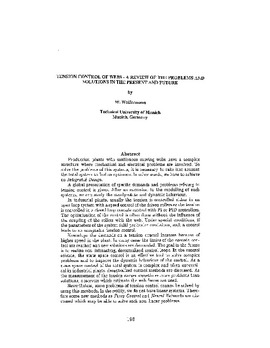| dc.contributor.author | Wolfermann, W. | |
| dc.contributor.other | International Conference on Web Handling (1995) | |
| dc.date.accessioned | 2019-11-05T16:50:47Z | |
| dc.date.available | 2019-11-05T16:50:47Z | |
| dc.date.issued | 1995-06 | |
| dc.identifier | oksd_icwh_1995_wolfermann | |
| dc.identifier.citation | Wolfermann, W. (1995, June). Tension control of webs - A review of the problems and solutions in the present and future. Paper presented at the Third International Conference on Web Handling (IWEB), Stillwater, OK. | |
| dc.identifier.uri | https://hdl.handle.net/11244/321706 | |
| dc.description.abstract | Production plants with continuous moving webs have a complex structure where mechanical and electrical problems are involved. To solve the problems of this systems, it is necessary to take into account the total system to find an optimum. In other words, we have to achieve an Integrated Design. | |
| dc.description.abstract | A global presentation of specific demands and problems referring to tension control is given. After an excursion to the modelling of such systems, we can study the steady-state and dynamic behaviour. | |
| dc.description.abstract | In industrial plants, usually the tension is controlled either in an open loop system with a speed control of the driven rollers or the tension is controlled in a closed loop cascade control with PI or PID controllers. The optimization of the control is often done without the influence of the coupling of the rollers with the web. Under special conditions, if the parameters of the system fulfill particular conditions, such a control leads to an acceptable tension control. | |
| dc.description.abstract | Nowadays the demands on a tension control increase because of higher speed in the plant. In many cases the limits of the cascade control are reached and new solutions are demanded. The goal in the future is to realize non-interacting, decentralized control loops. In the control science, the state space control is an effective tool to solve complex problems and to improve the dynamic behaviour of the control. As a state space control of the total system is complex and often unpractical in industrial plants, decentralized control methods are discussed. As the measurement of the tension causes sometimes more problems than solutions, observers which estimate the web forces are used. | |
| dc.description.abstract | Nevertheless, some problems of tension control cannot be solved by using this methods. In the reality, we do not have linear systems. Therefore some new methods as Fuzzy Control and Neural Networks are discussed which may be able to solve such non-linear problems. | |
| dc.format | application/pdf | |
| dc.language | en_US | |
| dc.publisher | Oklahoma State University | |
| dc.rights | In the Oklahoma State University Library's institutional repository this paper is made available through the open access principles and the terms of agreement/consent between the author(s) and the publisher. The permission policy on the use, reproduction or distribution of the article falls under fair use for educational, scholarship, and research purposes. Contact Digital Resources and Discovery Services at lib-dls@okstate.edu or 405-744-9161 for further information. | |
| dc.title | Tension control of webs - A review of the problems and solutions in the present and future | |
| osu.filename | oksd_icwh_1995_wolfermann.pdf | |
| dc.type.genre | Conference proceedings | |
| dc.type.material | Text | |
